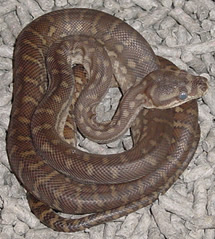Morelia bredli
| Morelia bredli | |
|---|---|

| |
| Scientific classification | |
| Domain: | Eukaryota |
| Kingdom: | Animalia |
| Phylum: | Chordata |
| Class: | Reptilia |
| Order: | Squamata |
| Suborder: | Serpentes |
| Family: | Pythonidae |
| Genus: | Morelia |
| Species: | M. bredli
|
| Binomial name | |
| Morelia bredli (Gow, 1981)
| |
| Synonyms[2] | |
| |
Morelia bredli is a species of non-venomous snake in the family Pythonidae. The species is endemic to Australia. There are no subspecies that are recognized as being valid.[3] Its common names include Bredl's python, Centralian python, Centralian carpet python, central Australian carpet python, Bredl's carpet python, central Australian Bredl's carpet python, and central Bredl's carpet python.
Etymology
The specific name, bredli, is in honor of Australian crocodile conservationist Josef "Joe" Bredl (1948–2007), brother of "the barefoot bushman", Rob Bredl.[4]
Description
M. bredli is moderately robust python that generally grows to 6.5-7' (2-2.2m)long, although some individuals grow to 8' (2.4m) or more.[5] The color pattern consists of a brown to reddish ground color with a highly variable pattern of pale intrusions. There are normally black borders around the intrusions that become more extensive around the tail. The belly is yellowish to pale cream.[6]
Geographic range
In Australia, M. bredli is found in the mountains of southern Northern Territory. The type locality given is "Pitchie Ritchie Park, Alice Springs, Northern Territory, Australia (23°42', 133°51')".[2]
Habitat
M. bredli is found in a variety of habitats: desert, savanna, forest, and freshwater wetlands, inhabiting ranges, ridges, and rocky outcrops.[1] They are semi-arboreal, spending time both on the ground and in trees, and may be found active during the day or night.[5]
Reproduction
References
- ^ a b Cogger, H.; Fenner, A.; Hutchinson, M.; McDonald, P. (2017). "Morelia bredli". IUCN Red List of Threatened Species. 2017: e.T42494066A42494080. doi:10.2305/IUCN.UK.2017-3.RLTS.T42494066A42494080.en. Retrieved 18 November 2021.
- ^ a b McDiarmid RW, Campbell JA, Touré T (1999). Snake Species of the World: A Taxonomic and Geographic Reference, Volume 1. Washington, District of Columbia: Herpetologists' League. 511 pp. ISBN 1-893777-00-6 (series). ISBN 1-893777-01-4 (volume).
- ^ "Morelia bredli ". Integrated Taxonomic Information System. Retrieved 11 September 2007.
- ^ Beolens B, Watkins M, Grayson M (2011). The Eponym Dictionary of Reptiles. Baltimore: Johns Hopkins University Press. xiii + 296 pp. ISBN 978-1-4214-0135-5. (Morelia bredli, pp. 37-38).
- ^ a b Healey, Mariah. "Bredl's Python Care Sheet". ReptiFiles. Retrieved 2022-01-18.
{{cite web}}: CS1 maint: url-status (link) - ^ Centralian Carpet Python, Morelia spilota bredli Archived 2008-07-19 at the Wayback Machine at the Snake Ranch. Accessed 11 April 2008.
- ^ Species Morelia bredli at The Reptile Database www.reptile-database.org.
Further reading
- Cogger HG (2014). Reptiles and Amphibians of Australia, Seventh Edition. Clayton, Victoria, Australia: CSIRO Publishing. xxx + 1,033 pp. ISBN 978-0643100350. (Morelia bredli, p. 826).
- Gow GF (1981). "A new species of python from central Australia". Australian Journal of Herpetology. 1 (1): 29–34. (Python bredli, new species).

